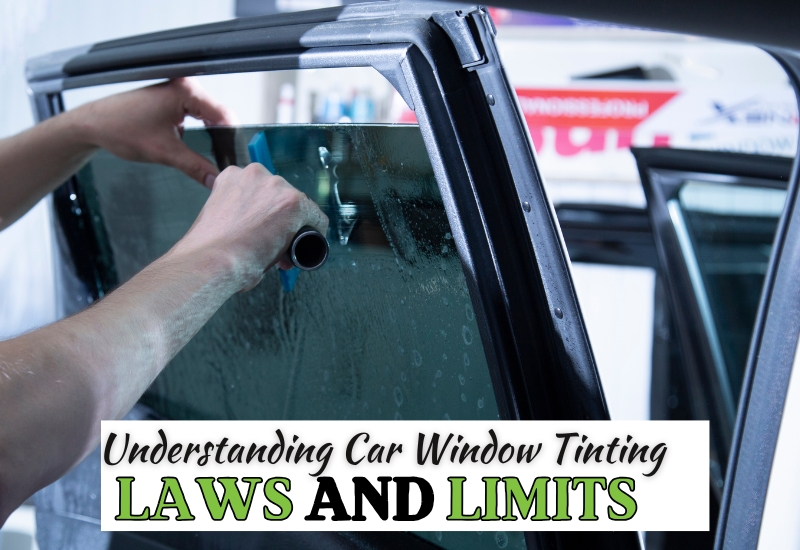Car window tinting has become increasingly popular over the years for its ability to enhance vehicle appearance, provide UV protection, reduce interior heat, and increase privacy. However, despite its many benefits, car window tinting is also heavily regulated. These laws are in place to ensure safety for both drivers and law enforcement officers. Failing to comply with your state or local tint laws could result in costly fines, required removal, and even failed vehicle inspections.
In this comprehensive guide, we’ll break down the basics of car window tinting laws, why they matter, how they vary by state, and what to keep in mind before having your vehicle’s windows tinted. Whether you're considering a tint job or already have one, understanding the legal limits is essential.
Why Are Window Tinting Laws Important?
Window tinting laws exist primarily for safety reasons. While tint offers numerous advantages, excessively dark tints can reduce visibility—especially at night—and make it harder for law enforcement to see inside the vehicle during traffic stops. Overly reflective or illegal tints can also endanger pedestrians, cyclists, and other drivers.
The right tint should strike a balance between providing privacy and protection without compromising visibility or safety. That’s why most states set limits on how dark and how reflective your window tint can be.
What is VLT and Why Does It Matter?
One of the most important terms you'll come across when researching tint laws is VLT—Visible Light Transmission. This is the percentage of visible light that can pass through your window and the tint film. A higher VLT means a lighter tint (more light gets through), while a lower VLT means a darker tint (less light passes through).
For example:
- A 70% VLT means 70% of light passes through (a very light tint)
- A 15% VLT means only 15% of light passes through (a much darker tint)
Most window tint laws are based on VLT, and the acceptable percentage can differ for each window on the vehicle—front, rear, and rear windshield.
Understanding Florida’s Window Tinting Laws
If you're tinting your car in Florida, here’s what you need to know:
- Front Side Windows: Must allow more than 28% of light in.
- Rear Side Windows: Must allow more than 15% of light in.
- Rear Window: Must allow more than 15% of light in.
- Windshield: Non-reflective tint is allowed above the AS-1 line (usually a line near the top of the windshield marked by the manufacturer).
- Reflectivity: Tint must not be more than 25% reflective on the front side windows and 35% on the rear windows.
For residents interested in car window tinting in Fort Lauderdale, it’s crucial to work with a professional who understands these legal boundaries and ensures compliance with Florida’s tinting laws. A licensed shop will provide films that meet legal standards and help you avoid any legal trouble.
Medical Exemptions for Tinting
In some cases, Florida allows drivers to apply for medical exemptions if they have a legitimate health reason for needing darker window tints. Conditions like lupus, melanoma, and photosensitivity disorders may qualify. However, this requires formal documentation and approval through the Florida Department of Highway Safety and Motor Vehicles (FLHSMV).
Medical exemptions are not automatic and must be carried in the vehicle at all times in case of a traffic stop.
Different Rules for Different Windows
Each section of your vehicle may be subject to different VLT rules. For instance:
- Windshields are the most restricted, only allowing tint at the top portion.
- Front side windows often must be significantly lighter than the rear.
- Rear and back windows usually allow darker tints, especially on SUVs and vans.
That’s why if you're getting car window tinting in Boynton Beach, it’s essential that your installer knows the tinting laws for each window section of your specific vehicle type (sedan, SUV, truck, etc.).
Factory Tint vs. Aftermarket Tint
Some vehicles come with factory tint—especially on rear windows. This tint is actually dyed glass and is not subject to the same laws as aftermarket films. However, if you apply additional tint film over factory-tinted windows, the combined VLT could make your vehicle non-compliant.
Many car owners mistakenly assume that since their rear windows are already dark, adding more tint is fine. But the combination might lower the VLT below the legal limit. When doing car window tinting in Pompano Beach, always ask your technician to measure the existing tint and recommend legal film combinations to stay compliant.
Penalties for Illegal Tint
Driving with illegal tint in Florida can result in:
- Fines
- Fix-it tickets requiring you to remove or replace the tint
- Vehicle inspection failures
- Points on your license in some cases
Repeated violations could even lead to increased insurance premiums or more serious consequences. This is why it’s not worth trying to “go darker” than the law allows.
The good news is, professional installers are aware of these limits. When scheduling car window tinting in Boca Raton, make sure the shop provides documentation certifying that your tint complies with Florida law.
Other Tint Restrictions
Aside from VLT, Florida law also restricts:
- Color of tint: Some colors (like red, amber, or blue) may not be permitted.
- Reflectivity: Highly mirrored or metallic tints can be distracting and are often illegal.
- Stickers: A sticker certifying legal tint is required and must be placed on the inside of the driver's door jamb.
These smaller regulations are sometimes overlooked, but they’re equally important for legal compliance and passing inspections.
Tips for Staying Legal and Protected
If you’re considering window tinting or want to double-check that your current tint is compliant, here are a few tips:
- Measure Before You Tint: A tint shop should use a VLT meter to test your windows before and after installation.
- Ask About Warranty and Certifications: Ensure your installer uses certified films and offers warranties that back up their product’s durability and legality.
- Keep Documentation: Hold onto the tint installation certificate and any medical exemption forms—you may need to present them to law enforcement or at inspections.
- Avoid DIY Mistakes: DIY kits may be tempting, but they often lead to incorrect installation and unintentional legal violations.
Conclusion
Understanding car window tinting laws and limits isn’t just about avoiding tickets—it’s about making safe, informed choices that keep you, your passengers, and other drivers protected. Florida has specific tinting rules that differ based on window location, reflectivity, and VLT, so staying compliant is a must.
Whether you're booking car window tinting in Boynton Beach, Pompano Beach, Boca Raton, or Fort Lauderdale, choose a professional service that’s knowledgeable about local laws. They can help you select the right film, ensure your tint is legal, and give you all the benefits of window tinting without any of the risks.
A properly installed and legally compliant window tint will enhance your vehicle’s appearance, improve comfort, and provide long-lasting UV protection—all while keeping you safe and on the right side of the law.






Comments